Before round three of the FIDE World Cup began, I wrote that one of the interesting matches would be Eljanov-Grischuk, because Eljanov so far had been the “irresistible force” (he had gone 4-0 to that point), while Grischuk had been the “immovable object.” (In round one Grischuk drew six games before finally winning, and in round two he drew five games before finally winning.)
Well, this time the irresistible force won hands-down, as Eljanov swept both games to run his record so far to 6-0. Up to this point you could write off Eljanov’s success as being due to less-than-challenging opposition. In round one the #26 Eljanov beat the #103 seed, Rinat Jumabayev (who?). In round two he beat the #90 seed, Alexader Ipatov. But in this round he beat a truly elite player, #7 Grischuk, again by a 2-0 score, and that has to be considered at least a minor sensation.
Is #26 perhaps a lucky number this month? The #26 seed also won the women’s U.S. Open tennis tournament. Just saying…
I think that Eljanov’s first win against Grischuk will be remembered a long time, and for all the wrong reasons. It created a huge stir among the spectators because both players combined for four huge blunders in a row, according to the computers. First Eljanov blundered, giving Grischuk a won position; then Grischuk blundered, giving Eljanov a drawable position; then Eljanov blundered, giving Grischuk a won position; then Grischuk blundered, giving Eljanov a won position.
Just a year ago, self-appointed chess experts all over the world were agog when Carlsen and Anand played a “double blunder” in their world championship match. “Such a thing has never happened in the world championship!” they hollered. Well, what are those experts thinking now about the quadruple blunder in Grischuk-Eljanov?
So you’re probably thinking that Grischuk-Eljanov was a terribly played game. Wrong! It was a FANTASTIC game. There is so much to learn from it. Yes, the computers are right. Technically, there were four blunders in a row. But the reality is that it was a phenomenally difficult position, and basically there was just one move, a miraculous one-in-a-million resource, that both players overlooked (or perhaps underrated) twice. I would say that’s one blunder, not four. Aside from that, both players coped quite well and played moves that are absolutely a model for how grandmasters handle such positions.
Here is where all the fun started.
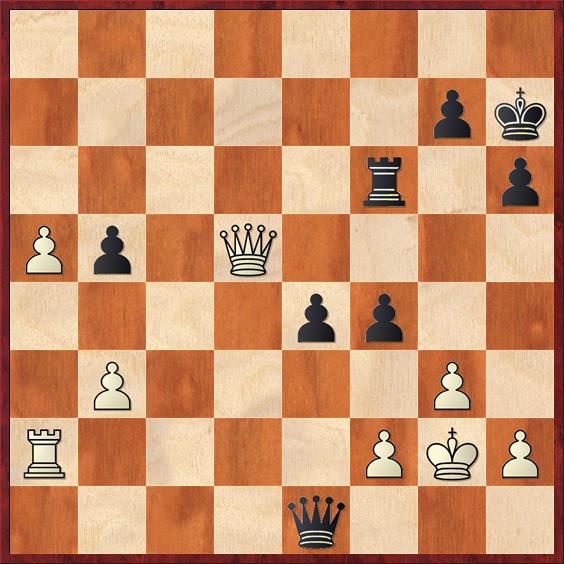 Position after 35. … f4. White to move.
Position after 35. … f4. White to move.
FEN: 8/6pk/5r1p/Pp1Q4/4pp2/1P4P1/R4PKP/4q3 w – – 0 36
Eljanov, playing Black, has just pushed his pawn to f4. This is a great fighting move, and even though it doesn’t win the game by force, it is the type of move that has gotten him to a 6-0 record so far. It’s important to note that Grischuk, playing White, was in great time trouble, and basically playing on the 30-second-per-move time increment until move 40.
In this position, especially in time trouble, I would almost certainly play 36. f3 as White. My first goal is not to get mated before move 40, and allowing Black to play 36. … f3 is a good way to get checkmated. There are some tactical points, too. For instance, if 36. f3 fg? 37. Qxe4+ looks very good for White. Or if 36. f3 e3? 37. Qe4+ Rg6 38. a6! fg 39. h4! Notice how White keeps all the lines closed, and the last move also threatens to win the pinned rook (an important theme in the game). Finally, if 36. f3 ef+ 37. Qxf3 fg? 38. Qd3+ White has nothing to fear and in fact stands better. It’s only when I put the game on Rybka that the computer found the right continuation for Black: 36. f3 ef+ 37. Qxf3 Qb1! This forces the rook off the a-file and leads to dead equality.
But Grischuk wasn’t in it to draw! He played 36. a6! Basically he’s saying to Black, “You can’t checkmate me before I promote my a-pawn.” A truly cold-blooded, fearless move, worthy of a grandmaster. And in time trouble, to boot. Wow. The next two moves are pretty easy: 36. … f3+ 37. Kh3.
Now we come to the four alleged blunders. Here, according to the computer, Eljanov should have played 37. … e3! The first key point is that after the obvious 38. Qxe3?? Qh1! White has no moves that would allow him to interpose on h3 after 39. … Qg2+ 40. Kh4 Qxh2+. So instead White has to take on f3 to cut the mating net, and he does this by means of 38. Qe4+! Rg6 39. Qxf3. And now we again get liquidation and a very drawish position after 39. … ef 40. Qxf2 Qxf2 41. Rxf2 Rxa6.
Why didn’t Eljanov play this? Well, I think it’s simple. He didn’t want to lose the e- and f-pawns, which are such great attacking pieces. Instead of plunging into an immediate sword fight, he played another move that he knew he would have to make anyway: 37. … Rg6??, securing his king and tightening the mating net around White’s king. This is a good rule: take away your opponent’s threats first, then go into the complications. Good players play this way. It works nine times out of ten.
How was he to know that this was the tenth time?
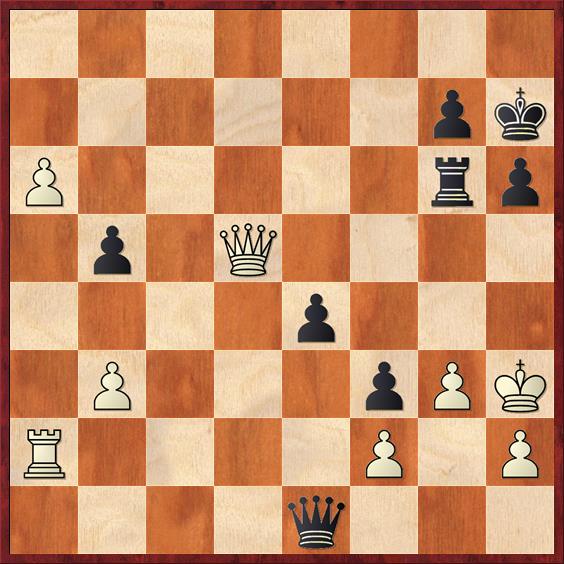 Position after 37. … Rg6. White to move.
Position after 37. … Rg6. White to move.
FEN: 8/6pk/P5rp/1p1Q4/4p3/1P3pPK/R4P1P/4q3 w – – 0 38
Here the computers were screaming, “White wins! White wins!” Stockfish, the engine running during the broadcast, gave White a 13-pawn advantage. Yes, Eljanov blew 13 pawns in one move, which is darned near impossible. My computer’s copy of Rybka, which is less excitable than Stockfish, gives White an 8-pawn advantage. Can you see what they see?
The answer is that White should just continue with the plan he initiated last move: 38. a7!, planning to promote next move. After 38. … Qh1, he should play 39. Qf5! (Not 39. a8Q?? because it would be mate in two after 39. … Qg2+.) Unexpectedly it turns out that this move shuts Black’s attack down. First, it prepares to interpose on h3, and second, it pins the rook on g6 so it can’t fully participate in the attack. If Black now tries to play 39. … e3, it’s too little too late. White wins with 40. a8Q e2 41. Qe8 — another nice offense-defense move, because it threatens to win the pinned rook and also defends the queening square in case Black goes for the check on h2 and queen trade on h3.
I guess Eljanov didn’t see 39. Qf5, and Grischuk, with only 30 seconds to move, didn’t see it either. Instead of 38. a7, he played 38. Kh4?? ,throwing away the win.
Even though this was a blunder, it shows a similar thought pattern to Eljanov’s. White first defuses the immediate threat (… Qh1) before plunging forward with a6-a7. The trouble is that plunging forward was the only way to win.
Now it was Eljanov’s turn to blunder, but again he played a completely natural move: 38. … Qb4??, threatening a huge discovered check.
Tsk-tsk, the computers say. Tsk-tsk, the spectators say, looking at their computers. Black had to play 38. … e3! After 39. Qxf3 ef we’re back to the same drawing variation as we were on the previous move, with the only difference that White’s king is on h4 instead of h3 (and that doesn’t make any difference).
Well, I’m sorry. 38. … Qb4 was the logical move. We’ve already seen that Eljanov was playing for a win, and he had turned down … e3 on the previous move because it didn’t offer enough winning chances and it gives away his best asset, the pawn on f3. If he didn’t play … e3 last move, he’s certainly not going to play it now. Especially because, as far as he can tell, 38. … Qb4 is winning!
Eljanov was applying a simple and important rule. If you do not see any way your opponent can defend after move A, and you’ve given it your best effort, you should play move A. You should not “chicken out” just because he is higher rated or because you might have missed something. Good players trust their analysis. I can’t tell you how many wins I’ve missed because I didn’t apply this rule. I don’t trust my analysis enough, and that’s why I’m only a 2200 player. Eljanov trusts his analysis, and that’s why he is a 2700 player. 38. … Qb4 would be the best move 9 times out of 10. 99 times out of 100.
How was he supposed to know that this was the hundredth time?
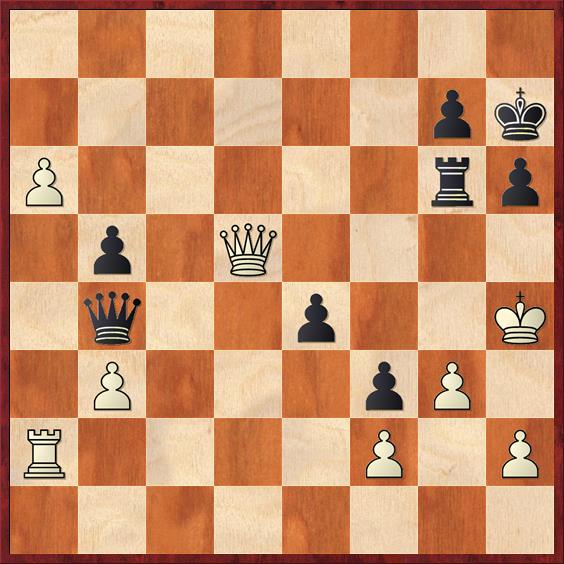 Position after 38. … Qb4. White to move.
Position after 38. … Qb4. White to move.
FEN: 8/6pk/P5rp/1p1Q4/1q2p2K/1P3pP1/R4P1P/8 w – – 0 39
What can White do about the threat of 39. … e3+? It looks like a disaster. In fact, I think that Grischuk might have been so concerned about the threat of queen checks on h2 that he missed the possibility of checks from the side. In time pressure, it’s a huge psychological shock when your opponent comes up with something you weren’t expecting. And so it is not the least bit surprising that Grischuk blundered with 39. Kh3?? Of course, he’s got to get out of the check, right?
Wrong! For the second straight move, White’s saving resource is 39. Qf5!! If Black plays 39. … e3+ as per plan, White’s king just keeps marching forward: 40. Kh5!! In spite of the fact that queens and rooks are roving all over the board, White’s king is immune and in fact he is White’s best attacking piece! Black loses his rook and surprisingly, his king — which only four moves earlier seemed to be completely safe — is now in more danger than White’s king. If, for example, 40. … ef 41. Qxg6+ Kh8 White can win pretty much however he pleases. Rybka likes 42. Rc2! ,which threatens a back-rank mate and chases Black’s queen back to f8.
It turns out (according to the computers) that after 39. Qf5!! a somewhat better try is 39. … Qxb3. After 40. Kh5 Qxa2 41. Qxg6+ Kh8 42. Qb7 Black pulls out a miraculous save of his own with 42. … Qe6!! forcing a draw by repetition. But White can forestall this variation with 40. Ra1!! and only after 40. … Qb2 does he play 41. Kh5, because now Black can’t get his queen to e6.
Whatever. I’d love to be able to think like a computer, but I’d settle for thinking like a grandmaster.
Okay, on with the game. After our four mega-blunders in a row (which really just amounted to neither player realizing what a good move Qf5 was), we’re now due for a good move. Eljanov played 39. … Rg5!, and all the computers are happy. Black is now winning — the mating net is just tight enough. Grischuk made the time control with 40. Qf7 (correct — he has to defend the h5 square) 40. … Qc5! (Black is in the driver’s seat now) 41. g4 (Forced. When you see this sort of move, you know White’s in trouble.) 41. … Qc1! (Again, great stuff. Notice how Black combines threats from the side and threats from behind.) 42. a7 (Might as well.) Let’s have another diagram.
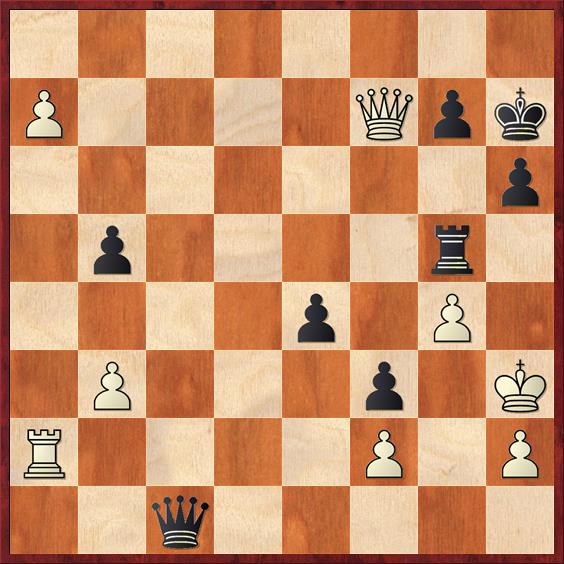 Position after 42. a7. Black to move.
Position after 42. a7. Black to move.
FEN: 8/P4Qpk/7p/1p4r1/4p1P1/1P3p1K/R4P1P/2q5 b – – 0 42
Now Eljanov again plays a superior move. I would have been strongly tempted to play 42. … Qh1?, which looks as if it’s just winning after 43. Qf4? Qg2+ 44. Kh4 Rxg4+!! 45. Qxg4 g5+ 46. Kh5 Qxh2+ . Unfortunately, the fly in the ointment is 43. Kg3, when Black has to settle for a draw with 43. … Qg1+ 44. Kf4 Qc1+ 45. Kg3 Qg1+, because if he tries 44. … Rxg4+ 45. Ke5 White’s king gets away.
Instead he played 42. … h5!, which probably would have been my #2 candidate move. It’s a natural move, opening lines against White’s king. The most dastardly point is 43. gh? Qc8+! forcing mate. Did you see that coming? I didn’t. I talked before about how the queen attacked White’s king from behind and the side, and here it leaps all the way across the board and attacks him from the diagonal. Wonderful stuff!
Also, notice that 43. a8Q runs into 43. … Qf1+ 44. Kh4 Rxg4+, a second point of the move 42. … h5! So Grischuk had to give up his queen with 43. Qxh5+ Rxh5+ 44. gh Qc8+ 45. Kg3 Qa8.
This is the point at which you think that chess must have been invented by sadists. Here Black has played beautiful chess (disregarding a couple of blunders due to playing moves that would ordinarily have been excellent). He has completely outplayed his opponent, and forced him to give up a queen for a rook. At this point the win should be easy. But it’s not! In fact, it’s not clear that Black is winning at all. Let’s go forward a few more moves to Grischuk’s last chance to save the game.
46. Ra6 Ka8 47. b4 Kf8 48. Kf4 Ke7 (diagram)
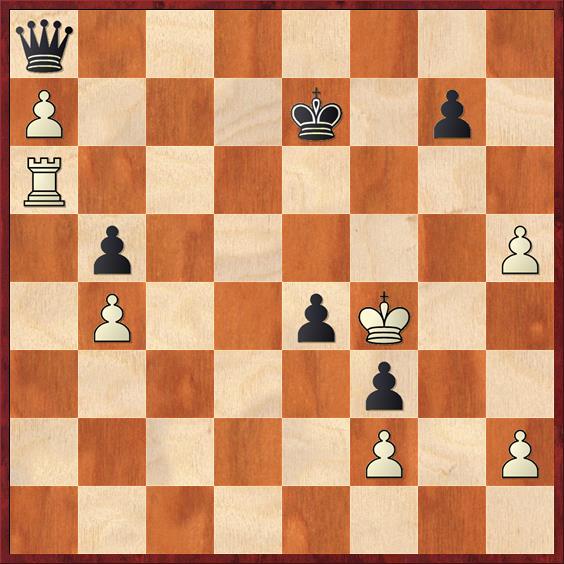 Position after 48. … Ke7. White to move.
Position after 48. … Ke7. White to move.
FEN: q7/P3k1p1/R7/1p5P/1P2pK2/5p2/5P1P/8 w – – 0 49
Here White could have played 49. h6! and it appears that he can hold a draw. Here are the points of 49. h6:
- Black can’t ignore it. If the pawn pushes on to h7, White wins.
- After the inevitable 49. … gh 50. Rxh6, Black of course cannot capture on a7 because of the x-ray check: 50. … Qxa7?? 51. Rh7+. This trick is basic knowledge to any grandmaster, but if you haven’t seen it before it’s a very good thing to know about.
- Black also can’t go for the rook with 50. … Qf8+ , because taking on h6 would allow White to promote his pawn.
- In all likelihood, Black will continue his plan of transferring the king to the queenside. But in that case, White will bring his rook back to a6 and will then run his passed h-pawn. Here is the kind of position he is looking for:
FEN: q7/P5k1/R6P/1p6/1P2pK2/5p2/5P2/8 b – – 0 58
Black cannot make progress here. His king needs to be on the kingside to defend against the h-pawn, and his queen needs to stay on a8 to defend against the a-pawn. He can never push the e-and f-pawns as long as White’s king stays in the vicinity. Draw.
5. The most difficult thing to see is that the zugzwang position we reach in the game (on move 54) would not be zugzwang if White were free to advance his h-pawn. This may be why Grischuk did not play 49. h6; he simply didn’t think that it would be necessary. He probably thought he could hold the position anyway, and did not realize that he would be put in zugzwang.
So Grischuk played 49. Ke3? On the surface, it’s a sensible move. He sees that Black’s plan is to move his king to b7 and then free the queen with a check, so Grischuk moves his king to a square where the queen can’t check him. Unfortunately, that is not Black’s only winning plan.
Also, note that after 49. Ke3 Black never has to worry about a future h6, because he will be able to capture on a7 with check and thus avoid the x-ray trick.
The game continued 49. … Kd7 50. Kd4 Kc7 51. Ke3 Kb7 52. Ra5 Kb6 53. Ra3 Kc6 54. Ra5 Kd6!
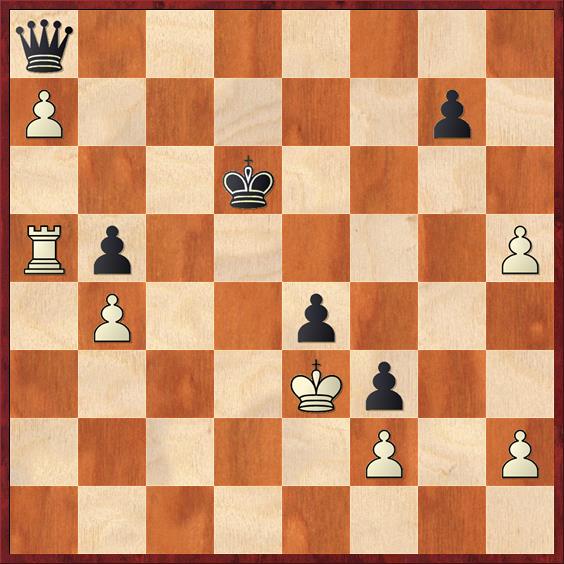 Position after 54. … Kd6. White to move.
Position after 54. … Kd6. White to move.
FEN: q7/P5p1/3k4/Rp5P/1P2p3/4Kp2/5P1P/8 w – – 0 55
The thing about zugzwang is that you never realize you’re in one right away. The knowledge dawns on you slowly, as you look at each possible move and realize that nothing works. It’s like in Hollywood movies, when somebody gets stabbed and nobody quite realizes it until they see the knife sticking out of his back, and then it’s “Oh… s***” and he hits the floor.
I wonder if Grischuk had the same “Oh s***” feeling?
Here’s why White is in zoog:
- Rook moves are no good because of 55. … Kd5. White needs to be able to react to this with 56. Rxb5+ immediately.
- 55. Kf4 is no good, again, because of 55. … Kd5. Although White gets his check with 56. Rxb5+, Black now penetrates with 56. … Kc4 57. Rc5+ Kd3! and e3 is coming next. This is the alternate winning plan that I alluded to earlier. This would not have been possible with White’s king at e3, which is why Black had to wait until he played Kf4.
- If White plays any moves with his h-pawns, Black will simply shuffle his king between e6 and d6 until White runs out of moves.
- Finally, if White plays 55. Kd4, we get what actually happened in the game:
55. Kd4 Qd5+! 56. Ke3 Ke5! White resigns.
White can finally promote his pawn, but gets checkmated immediately with 57. … Qd3 mate. Remember what I said Grischuk was thinking when he played 36. a6? “You can’t checkmate me before I promote my a-pawn.” Well, he was right. Eljanov checkmated him (or would have checkmated him) after he promoted the a-pawn.
What an amazing finish to an amazing game! I hope you enjoyed it as much as I did. Certainly the game does not deserve to be remembered as “the one where Grischuk and Eljanov blundered four times in a row.”
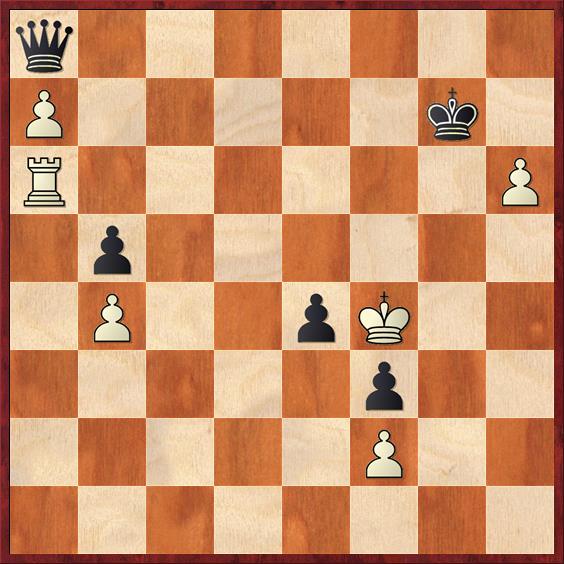



{ 2 comments… read them below or add one }
Very nice!!
What a coincidence!
I was just watching http://youtu.be/nfTdNRnIZCc
Cool! I see that Daniel King made most of the same points that I did, including the key fact that 54. … Kd6 is zugzwang. He didn’t mention 55. Kf4 Kd5 56. Rxb5+ Kc4 57. Rc5+ Kd3!, but I can’t take any credit for that because it was Rybka’s move.